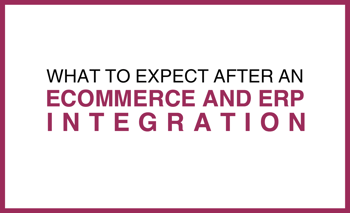
 Tips to keeping your eCommerce and ERP integration project on track after you go live
Tips to keeping your eCommerce and ERP integration project on track after you go liveCongratulations, you have reached the summit!
Your eCommerce and ERP integration project has reached go-live and the team is excited! Your new site is up and running and orders are starting to come in. After that initial sense of euphoria, reality begins to creep back in; you now realize that with this new system comes new responsibilities and, potentially, new problems. You now have to train your team and iron out any system kinks, while simultaneously managing daily operation and keeping up with customer service needs.
At this stage in the game, problems are not uncommon, so stay calm and don’t panic; you've got this! Here are some common things to expect after an eCommerce and ERP integration project go-live and how to effectively address them:
With everything new in life, there is a learning curve. Sometimes it only takes a week or two and other times it can take months before your team can fully realize your site’s capabilities. Previous customers are getting used to your new, more efficient system, and they need time to adjust to using it.
Don’t panic if/when the complaints and negative comments hit. Review each to determine if it is a technical problem or a human problem. If your system has drastically changed, consider creating a how-to guide for your customers.
Above all, react positively to the criticisms. Every complaint is an opportunity to improve customer services. Quick responses allowing you to effectively lead customers to the assistance they need makes for happier customers.
Expect things to get stuck. Even though the first couple of days have gone smoothly, do not fall into a false sense of security. What usually causes problems are the outliers or nonstandard transactions that happen infrequently and may have escaped testing. Stay diligent for several weeks to a month depending on the scope of the project.
Some transactions will be stuck in the system at go-live. Whatever they may be, you need to prepare by doing these two things:
Damage to the system is minimal when caught early, but if it goes on for weeks it can cause major problems. Companies often go through a cycle where the first week or two is quite rough, the next few weeks are consistent (but not necessarily great), and the end of the month shows some noticeable improvements. Remember the learning curve and don’t let any setbacks derail you.
At Briteskies, we typically ask our clients to set up a dedicated conference room or keep a conference line open for about two weeks after go-live. The purpose is to facilitate direct communication between us rather than relying solely on technology and the use of ticketing systems to report problems. The last thing we want our clients to experience is more frustration because the system isn’t quite working right and their concerns are not addressed directly. There is nothing more frustrating to a customer than being made to feel like no one is listening to them.
You now have an awesome new data gathering process that will allow you to better serve your customers. Most companies find that ERP integration reduces the time between sales order placement and sales order shipment and increases the overall efficiency of a system. With your newly integrated system, consider using a few conversion tactics to drive traffic through your site. Good luck!
For a closer look at a successful eCommerce and ERP integration project, download the case study below.
Special thanks to Dave Balser, Briteskies JD Edwards Delivery Director, for sharing some of the common situations faced by clients and how to avoid them.
Lorem ipsum dolor sit amet, consectetur adipiscing elit

For the past two decades, we've made it our business to help you work smarter. From commerce challenges to ERP customizations, we support the power of your big ideas by helping you work more strategically, more intuitively, and more efficiently.
2658 Scranton Road, Suite 3
Cleveland, Ohio 44113
216.369.3600
No Comments Yet
Let us know what you think